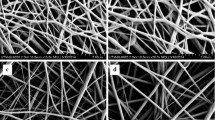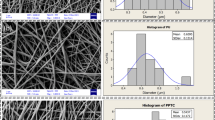Abstract
The organic/Inorganic nanocomposite poly-ortho-toluidine-TiO2 was synthesized by chemical oxidative polymerization in the presence of TiO2 using ammonium peroxo-disulfate as an oxidizing agent. The POT + TiO2/PCL composite film scaffolds were fabricated by solvent casting technique. The prepared POT + TiO2/PCL composite film was characterized through X-Ray diffraction (XRD), Fourier transform infrared (FT-IR)spectroscopy, Field emission scanning electron microscopic studies (FESEM) with EDS techniques.The conductivity measurement of the samples was carried out at room temperature by standard two probe technique using KEITHLEY electrometer. The surface roughness of composites was measured using a 3D laser profilometry–Zeta Optical–Profilometer. The diffraction pattern of POT + TiO2/PCL composite film suggests the semicrystalline nature of the composites.FT-IR spectra confirms the formation of POT + TiO2/PCL composite film. The inclusion of POT + TiO2 component confirmed by FT-IR spectra also by the color change observed while blending PCL with POT + TiO2. The FE-SEM images of POT + TiO2 composites possesses the granular and spherical morphology also the TiO2 nanoparticle seems to be well dispersed in POT. The EDX spectra confirms the presence of all elements in the POT + TiO2/PCL composites.The POT + TiO2 nanocomposites have conductivity in the semiconducting range 0.13 × 10–7(S/Cm). Similarly, the DC conductivity of the POT + TiO2/PCL film becomes semiconducting range 0.04 × 10–8 (S/Cm). Surface roughness provides a great influence on the viability of different cells. The activity of Vero cells on both the composites was detected through MTT technique to determine the toxicity of the samples. In vitro antibacterial activities of POT + TiO2 and POT + TiO2/PCL composite scaffold were evaluated on gram-positive Staphylococcus aureus (S. aureus) and gram-negative Escherichia coli (E. coli) bacteria using well diffusion technique.POT + TiO2/PCL composite scaffold with improved surface roughness, cell viability and antibacterial activity. This work provides an economic and convenient method which eliminates the insolubility and nondegradability of conducting polymers and to prepare POT + TiO2/PCL-based composites for tissue engineering applications








Similar content being viewed by others
References
Borriello A, Guarino V, Schiavo L, Alvarez-Perez MA, Ambrosio L (2011) Optimizing PANi doped electroactive substrates as patches for the regeneration of cardiac muscle. J Mater Sci: Mater Med 22:1053–1062
Guimard NK, Gomez N, Schmidt CE (2007) Conducting polymers in biomedical engineering. Prog Polym Sci 32:876–921
Balint R, Cassidy NJ, Cartmell SH (2014) Conductive polymers: towards a smart biomaterial for tissue engineering. Acta Biomater 10(6):2341–2353
Guo B, Peter XM (2018) Conducting polymers for tissue engineering. Biomacromolecules 19(6):1764–1782
Kaur G, Adhikari R, Cass P, Bown M, Gunatillake P (2015) Electrically conductive polymers and composites for biomedical applications. RSC Adv 5:37553–37567
Shi G, Rouabhia M, Wang Z, Dao LH, Zhang Z (2004) A novel electrically conductive and biodegradable composite made of polypyrrole nanoparticles and polylactide. Biomaterials 25:2477–2488
Collier JH, Camp JP, Hudson TW, Schmidt CE (2000) Synthesis and characterization of polypyrrole–hyaluronic acid composite biomaterials for tissue engineering applications. J Biomed Mater Res 50:574–584
Cui X, Hetke JF, Wiler JA, Anderson DJ, Martin DC (2001) Electrochemical deposition and characterization of conducting polymer polypyrrole/PSS on multichannel neural probes. Sens Actuators A 93:8–18
Yamagishi FG, Stanford TB Jr, VanAst CI (2001) Biosensors from conducting polymer transducers and sol–gel encapsulated bioindicator molecules. Proc Electrochem Soc 18:213–223
Gómez-Quintero T, Arroyo-Ornelas MA, López-Marín LM, Castaño-Meneses VM, Garcia-Contreras R, Acosta-Torres LS, Arenas-Arrocena MC (2019) Cytotoxicity of polypyrrole and polyaniline matrixes for biosensors. Acta Sci Med Sci 3(5):81–89
Kotwal A, Schmidt CE (2001) Electrical stimulation alters protein adsorption and nerve cell interactions with electrically conducting biomaterials. Biomaterials 22:1055–1064
Kamalesh S, Tan P, Wang J, Lee T, Kang ET, Wang CH (2000) Biocompatibility of electroactive polymers in tissues. J Biomed Mater Res 52:467–478
Dispenza C, Leone M, Presti CL, Librizzi F, Spadaro G, Vetri V (2006) Optical properties of biocompatible polyaniline nano-composites. J Non-Cryst Solids 352:3835–3840
Kim YD, Kim JH (2008) Synthesis of polypyrrole-polycaprolactone composites by emulsion polymerisation and the electro rheological behaviour of their suspensions. Colloid Polym Sci 286:631–637
Islam S, Ganaie M, Ahmad S, Siddiqui AM (2014) Zinc Oxide (ZnO) doped poly(o-toluidine): synthesis and characterization. Adv Sci Lett 20:1710–1714
Bavastrello V, Sandrocarrara MK, Nicolin RC (2004) Optical and electrochemical properties of poly (o-toluidine)/multi walled carbon nanotubes composites langmuir-schaefer films. Langmuir 20:969–973
Ziadan KM, Hussein HF, Ajeel KI (2012) Study of electrical characteristics of poly(o-toluidine) and application in solar cell. Energy Procedia 18:157–164
Abouelaoualim A, Berrada K, Ameziane EL (2007) Spectroscopic characterization of electrodeposited poly(o-toluidine) thin films and electrical properties of ITO/Poly(o-toluidine)/aluminum schottky diodes. Act Passiv Electron Compon. https://doi.org/10.1155/2007/17846
Zhou T, Xie X, Cai J, Yin L, Ruan W (2015) Preparation of poly(o-toluidine)/TiO2 nanocomposite films and application for humidity sensing. Polym Bull 73(3):621–630
Pathampriyal R, Alagumuthu G (2018) Photocatalytic activity of TiO2/POT core-shell nanocomposite on eosin yellow dye. IJSRR 7(4):2431–2441
Turner JN, Shain W, Szarowski DH, Andersen M, Martins S, Isaacsin M et al (1999) Cerebral astrocyte response to micromachined silicon implants. Exp Neurol 156:33–49
Weidland JD, Anderson DJ (2000) Chronic neural stimulation with thin-film, iridium oxide electrode. IEEE Trans BioMed Eng 47:911–918
Ahmed HB, Emam HE, Mashaly HM, Rehan M (2018) Nanosilver leverage on reactive dyeing of cellulose fibers: color shading, color fastness and biocidal potentials. Carbohyd Polym 186:310–320
Ahmed HB, Emam HE (2019) Synergistic catalysis of monometallic (Ag, Au, Pd) and bimetallic (Ag Au, Au Pd) versus trimetallic (Ag-Au-Pd) nanostructures effloresced via analogical techniques. J Mol Liq 287:110975
Emam HE (2019) Arabic gum as bio-synthesizer for Ag–Au bimetallic nanocomposite using seed-mediated growth technique and its biological efficacy. J Polym Environ 27:210–223
Emam HE, Ahmed HB (2019) Comparative study between homo-metallic & hetero-metallic nanostructures based agar in catalytic degradation of dyes. Int J Biol Macromol 138:450–461
Ahmed HB, Mikhail MM, El-Sherbiny S, Nagy KS, Emam HE (2020) pH responsive intelligent nano-engineer of nanostructures applicable for discoloration of reactive dyes. J Colloid Interface Sci 561:147–161
Emam HE, Saad NM, Abdallah AEM, Ahmed HB (2020) Acacia gum versus pectin in fabrication of catalytically active palladium nanoparticles for dye discoloration. Int J Biol Macromol 156:829–840
Hemraj MY, Sachin VO, Valmiki BK, Sawanta SM, Chang KH, Shivaji HP, Sagar DD (2014) Preparation and characterisation of copper-doped anatase TiO2 nanoparticles with visible light photocatalytic antibacterial activity. J Photochem Photobiol A Chem 280:32–38
Wu S, Weng Z, Liu X, Young KWK, Chu PK (2014) Funtionalized TiO2 based nanomaterials for biomedical applications. Adv Funct Mater 24:5464–5481
Salarian M, Xu WZ, Wang Z, Sham JK, Charpentier PA (2014) Hydroxyapatite-TiO2 – based nanocomposites synthesized in super critical CO2 for bone tissue engineering: physical and mechanical properties.ACS Appl. Mater Interfaces 19:16918–16931
Jayakumar R, Roshni R, Divyarani VV, Chennazhi KP, Tamura H, Nair SV (2011) Fabrication of chitin-chitosan/nano TiO2 –composite scaffolds for tissue engineering applications. Int j Biol Macromol 48:336–344
Guo B, Glavas L, Albertsson A-C (2013) Biodegradable and electrically conducting polymers for biomedical applications. Prog Polym Sci 38:1263–1286
Ebrahimiasl S, Zakaria A, Kassim A, Basri SN (2015) Novel conductive polypyrrole/ zinc oxide/chitosan bionanocomposite: synthesis, characterisation, antioxidant, and antibacterial activities. Int J Nanomedicine 10:217–227
Liu Y, Yin P, Chen J, Cui B, Zhang C, Feng W (2020) Conducting polymer-based composite materials for therapeutic implantations: from advanced drug delivery system to minimally invasive electronics. Int J Polym Sci 2020:1–16
Liu F, Yuan Y, Li L, Shang S, Yu X, Zhang Q, Jiang S, Wu Y (2015) Synthesis of polypyrrole nanocomposites decorated with silver nanoparticles with electrocatalysis and antibacterial property. Compos Part B Eng 69:232–236
Ghaffari-Moghaddam M, Eslahi H (2014) Synthesis, characterization and antibacterial properties of a novel nanocomposite based on polyaniline/polyvinyl alcohol/Ag. Arab J Chem 7:846–855
Boomi P, Prabu HG, Mathiyarasu J (2013) Synthesis and characterization of polyaniline/Ag–Pt nanocomposite for improved antibacterial activity. Colloids Surf B 103:9–14
Wan Y, Wen DJ (2005) Preparation and characterization of porous conducting poly (DL-lactide) composite membranes. J Membr Sci 246:193–194
Liang Y, Goh JC-H (2020) Polypyrrole-incorporated conducting constructs for tissue engineering applications: a review. Bioelectricity 2(2):101–119
Freed LE, Vunjaknovakovic G, Biron RJ, Eagles DB, Lesnoy DC, Barlow SK, Langer R (1994) Biodegradable polymer scaffolds for tissue engineering. Biotechnology 12:689–693
Albertsson AC, Varma IK (2003) Recent developments in ring opening polymerisation of lactones for biomedical applications. Biomacromol 4:1466–1486
Place ES, George JH, Williams CK, Stevens MM (2009) Synthetic polymer scaffolds for tissue engineering. Chem Soc Rev 38:1139–1151
Mondal D, Griffith M, Venkatraman SS (2016) Polycaprolactone-based biomaterials for tissue engineering and drug delivery: current scenario and challenges. Int j Polym Mater Polym Biomater 65(5):255–265
Shakir M, Khan MS, Al-Re says SI, Baig U, Alam P, Khan RH, Alam M (2014) In-vitro DNA binding, molecular docking and antimicrobial studies on a newly synthesized Poly(O-toluidine)-titanium dioxide nanocomposites. RSC Adv 4:39174–39183
Wadatkar NS, Waghuley SA (2012) Characterisation of PANI-PVA composite thin films using XRD analysis. Sci Revs Chem Commun 2(3):392–394
Zhang H (2011) Characterization of electrospun poly(lactic acid)/polyaniline blend nanofibers. Adv Mater Res 332–334:317–320
Ponnamma D, Sadasivuni KK, Strankowski M, Kasak P, Krupa I, Al-Maadeed MASA (2016) Eco-friendly electromagnetic interference shielding materials from flexible reduced graphene oxide filled polycaprolactone/polyaniline nanocomposites. Polym-Plast Technol Eng 55(9):920–928
Ebrahim SM, Gad A, Morsy A (2010) Highly crystalline and soluble dodecyl benzene sulfonic acid doped poly(O-toluidine). Synth Met 160:2658–2663
Chun-Cheng Wu J (2013) Nanofibrous polyaniline: an antioxidative and antimicrobial polymer with potential tissue-engineering and related applications. University of Auckland, Auckland
Joseph SK, Sultana N (2016) Fabrication and characterisation of PCL/HA/PPY composite scaffold using freeze-drying technique. Jurnal Teknologi (Sci Eng). 78(12):89–94
Gok A, Sari B (2002) Chemical synthesis and characterisation of some conducting polyaniline derivatives : investigation of the effect of protonation medium. J Appl Polym Sci 84:1993–2000
Jumat NA, Wai PS, Ching JJ, Basirum WJ (2017) Synthesis of polyaniline-TiO2 nanocomposites and their application in photocatalytic degradation. Polym polym compos 25:507–514
de Moraes Cordeiro MA, Debora Goncalves LO, de sousa Bulhoes Joao, Cordeiro MM (2005) Synthesis and characterisation of poly-o-toluidine: Kinetic and structural aspects. Mat. Res 8:5–10
Rajakani P, Vedhi C (2015) Electrocatalytic properties of polyaniline-TiO2 nanocomposites. Int J Ind Chem 6:247–259
Asha SL, Goyal KD, Shyam kumar and Kishore N, (2014) Synthesis and characterization of polyaniline/TiO2 composites. Indian J Pure Appl Phys 52:341–347
Wang JC, Zheng H, Chang MW, Ahmad Z, Li JS (2017) Preparation of active 3D film patches via alighned fiber electrohydro dynamic (EHD) Printing. Sci Rep 7:43924
Strumpler R, Glatz-Reichenbach J (1999) Conducting polymer composites. J Electro Ceramics 3:329–346
Vyas S, Shivhare S, Shukla A (2017) Polyaniline (PANI) metal oxide nanocomposites as a conducting material. Int J Res Sci Innov (IJRSI) 4:86–89
Abedalwafa M, Fujun Wang L, Wang CL (2013) Biodegradable Poly-Epsilan-Caprolactone (PCL) for tissue engineering applications-a review. Rev Adv Mater Sci 34:123–140
Stodolak-Zych E, Szumera M, Blazewicz M (2013) Osteoconductive nanocomposite materials for bone regeneration. Mater Sci Forum 730–732:38–43
Bauer S, Park J, Faltenbacher J, Berger S, von der Mark K, Schmuki P (2009) Size selective behaviour of mesenchymal stem cells on ZrO2 and TiO2 nanotube arrays. RSC. Integr Biol 1:525–532
Gelmi A, Ljunggren MK, Rafat M, Jager EWH (2014) Influence of conducting polymer doping on the viability of cardiac progenitor cells. J Mater Chem B 2:3860–3867
Zhou JF, Wang YG, Cheng L, Wu Z, Sun XD, Peng J (2016) Preparation of polypyrrole-embedded electrospun poly (lactic acid) nanofibrous scaffold for nerve tissue engineering. Neural Regen Res 11:1644–1652
Thomas A, Raj MS, Venkataramana J (2014) Interaction mode of polycarbazole-titanium dioxide nanocomposite with DNA-molecular docking simulation and in-vitro antimicrobial study. Int J Bioassays 3:3106–3110
Haghi M, Hekmatafshar M, Faraz MK, Sayyadifar F, Ghaedi M (2012) Antibacterial effect of TiO2 nanoparticles on pathogenic strain of E.Coli. Intl. J Adv Biotec Res 3:621–624
Cao L, Xiaofeng W, Wang Q, Wang J (2017) Biocompatible nanocomposite of TiO2 incorporated bi-polymer for articular cartilage tissue regeneration: a facile material. J Photochem Photobiol B: Biol 178:440–446
Author information
Authors and Affiliations
Corresponding author
Additional information
Publisher's Note
Springer Nature remains neutral with regard to jurisdictional claims in published maps and institutional affiliations.
Rights and permissions
About this article
Cite this article
Balan, R., Gayathri, V. In-vitro and antibacterial activities of novel POT/TiO2/PCL composites for tissue engineering and biomedical applications. Polym. Bull. 79, 4269–4286 (2022). https://doi.org/10.1007/s00289-021-03707-9
Received:
Revised:
Accepted:
Published:
Issue Date:
DOI: https://doi.org/10.1007/s00289-021-03707-9




